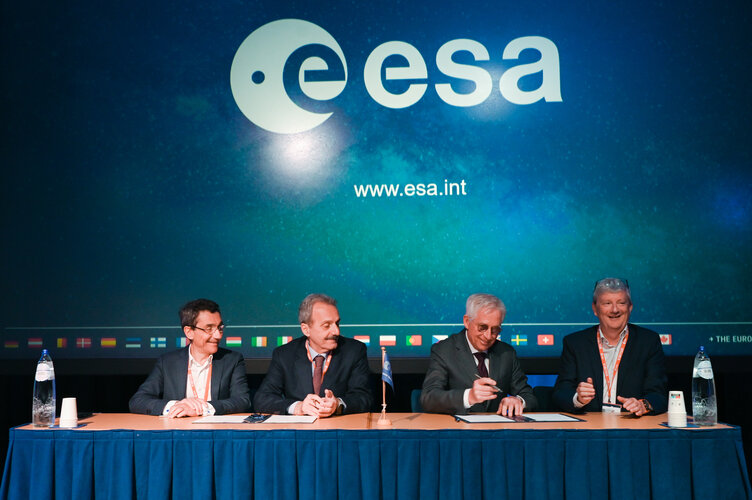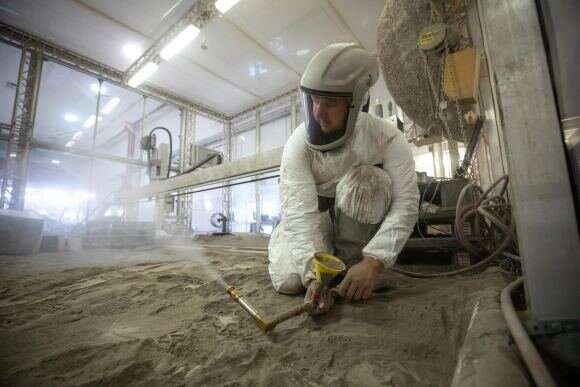
Copernical Team
Lockheed Martin working with US Army to improve space-enabled defense systems
 Lockheed Martin signed a Cooperative Research and Development Agreement (CRADA) with the U.S. Army Combat Capabilities Development Command's Aviation and Missile Center (AvMC) to advance Beyond Line of Sight (BLOS) connectivity. Under this CRADA, Lockheed Martin and AvMC will jointly develop and demonstrate space-enabled defense systems.
What It Means: Through this CRADA, Lockheed Martin a
Lockheed Martin signed a Cooperative Research and Development Agreement (CRADA) with the U.S. Army Combat Capabilities Development Command's Aviation and Missile Center (AvMC) to advance Beyond Line of Sight (BLOS) connectivity. Under this CRADA, Lockheed Martin and AvMC will jointly develop and demonstrate space-enabled defense systems.
What It Means: Through this CRADA, Lockheed Martin a Momentus to deliver Lunasonde technology demonstration payload to orbit
 Momentus Inc. (NASDAQ: MNTS) has signed a contract with Lunasonde to deliver the Picacho CubeSat to orbit.Lunasonde is a sub-surface imaging company with the goal of making underground resources - like water and minerals - easier to find.
The Picacho CubeSat is a technology demonstration of Lunasonde's sensors. It will measure the power spectral density of low-frequency radio signals in th
Momentus Inc. (NASDAQ: MNTS) has signed a contract with Lunasonde to deliver the Picacho CubeSat to orbit.Lunasonde is a sub-surface imaging company with the goal of making underground resources - like water and minerals - easier to find.
The Picacho CubeSat is a technology demonstration of Lunasonde's sensors. It will measure the power spectral density of low-frequency radio signals in th Viasat completes acquisition of Inmarsat
 Viasat Inc., (NASDAQ: VSAT), a global communications company, has announced the completion of its acquisition of Inmarsat. The combined company enhances our scale and scope to continue to drive growth in the increasingly dynamic and competitive satellite communications industry. The company's assets, once fully integrated, are expected to increase the pace and scope of innovation in the global s
Viasat Inc., (NASDAQ: VSAT), a global communications company, has announced the completion of its acquisition of Inmarsat. The combined company enhances our scale and scope to continue to drive growth in the increasingly dynamic and competitive satellite communications industry. The company's assets, once fully integrated, are expected to increase the pace and scope of innovation in the global s A telescope's last view
 More than 5,000 planets are confirmed to exist beyond our solar system. Over half were discovered by NASA's Kepler Space Telescope, a resilient observatory that far outlasted its original planned mission. Over nine and a half years, the spacecraft trailed the Earth, scanning the skies for periodic dips in starlight that could signal the presence of a planet crossing in front of its star.
I
More than 5,000 planets are confirmed to exist beyond our solar system. Over half were discovered by NASA's Kepler Space Telescope, a resilient observatory that far outlasted its original planned mission. Over nine and a half years, the spacecraft trailed the Earth, scanning the skies for periodic dips in starlight that could signal the presence of a planet crossing in front of its star.
I Novel docking system to be tested on the International Space Station
 Similar to the droids we see in movies, astronauts on the International Space Station (ISS) use their own free-flying robotic helpers called Astrobees. Queen, Honey, and Bumble are a trio of cube-shaped robots buzzing around station. They assist crew members with a multitude of tasks, including helping to perform ISS National Laboratory-sponsored investigations to test new technology that could
Similar to the droids we see in movies, astronauts on the International Space Station (ISS) use their own free-flying robotic helpers called Astrobees. Queen, Honey, and Bumble are a trio of cube-shaped robots buzzing around station. They assist crew members with a multitude of tasks, including helping to perform ISS National Laboratory-sponsored investigations to test new technology that could Orbit Fab selects Impulse Space to support GEO refueling mission
 Impulse Space has announced a hydrazine refueling demonstration mission in geostationary equatorial orbit (GEO), where its Mira orbital service vehicle will serve as a hosting platform for the Orbit Fab fuel depot set to replenish Space Force Satellites in 2025.
"We are eager to collaborate with Orbit Fab, a forerunner in commercial spacecraft refueling services," said Impulse Space Chief
Impulse Space has announced a hydrazine refueling demonstration mission in geostationary equatorial orbit (GEO), where its Mira orbital service vehicle will serve as a hosting platform for the Orbit Fab fuel depot set to replenish Space Force Satellites in 2025.
"We are eager to collaborate with Orbit Fab, a forerunner in commercial spacecraft refueling services," said Impulse Space Chief Canadian NIRISS instrument on Webb maps an ultra-hot Jupiter atmosphere
 There's an intriguing exoplanet out there - 400 light-years out there - that is so tantalising that astronomers have been studying it since its discovery in 2009. One orbit for WASP-18 b around its star that is slightly larger than our Sun takes just 23 hours. There is nothing like it in our Solar System.
A new study led by Universite de Montreal Ph.D. student Louis-Philippe Coulombe about
There's an intriguing exoplanet out there - 400 light-years out there - that is so tantalising that astronomers have been studying it since its discovery in 2009. One orbit for WASP-18 b around its star that is slightly larger than our Sun takes just 23 hours. There is nothing like it in our Solar System.
A new study led by Universite de Montreal Ph.D. student Louis-Philippe Coulombe about 30 Kilometers and Counting: Sols 3845-3847
 Earth planning date: Tuesday, May 30, 2023. What do you do when you are driving through challenging terrain? Well, hit a new record! Tosol we have passed the 30 kilometer mark! That's a Mars rover milestone only the NASA Opportunity rover has reached so far. That was around June 2011 and just over 2610 sols into the mission with Opportunity on its way between Victoria and Endeavour Crater. At En
Earth planning date: Tuesday, May 30, 2023. What do you do when you are driving through challenging terrain? Well, hit a new record! Tosol we have passed the 30 kilometer mark! That's a Mars rover milestone only the NASA Opportunity rover has reached so far. That was around June 2011 and just over 2610 sols into the mission with Opportunity on its way between Victoria and Endeavour Crater. At En Galileo Second Generation enters full development phase

The main procurements batch of Galileo Second Generation initiated last summer has been finalised, leaving the system ready for its In Orbit Validation development phase. Today, following the opening session of the European Navigation Conference (ENC), ESA Director of Navigation Javier Benedicto invited Thales Alenia Space (Italy), Airbus Defence and Space (Germany) and Thales Six GTS (France) to sign the respective contracts commencing System Engineering Support for the next generation of Europe’s navigation satellite system.
How much damage will lunar landings do to lunar orbiters?

Multiple missions are destined for the moon in this decade. These include robotic and crewed missions conducted by space agencies, commercial space entities, and non-profit organizations. The risks and hazards of going to the moon are well-documented, thanks to Apollo Program and the six crewed missions it sent to the lunar surface between 1969 and 1972. But unlike the "footprints and flags" of yesterday, the plan for the coming decade is to create a "sustained program of lunar exploration and development."
This means establishing a greater presence on the moon, building infrastructure (like habitats, power systems, and landing pads), and missions regularly coming and going. Given the low-gravity environment on the moon, spacecraft kick up a lot of lunar regolith (aka.

